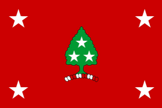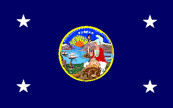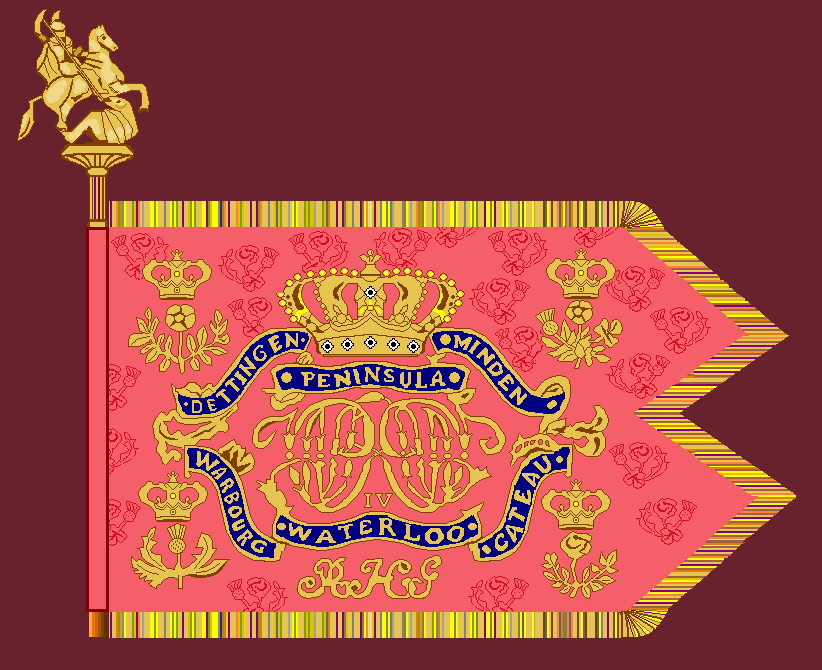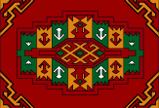- GUARDANT
- The heraldic term used when an animal has its face towards the onlooker – gardant (see also
‘affronty’ and ‘caboshed’).
![[example of guardant]](../images/v/vxt-d365.gif)
![[example of guardant]](../images/v/vxt-d3104.gif)
![[example of guardant]](../images/v/vxt-d3105.gif)
Flag of the Duchy of Lancaster, UK;
Flag of Häggenschwil, Switzerland;
Flag of the Cinque Ports, UK
- GUBERNATORIAL FLAG
- In US usage, the term for a flag which symbolizes the
office of governor – a governor’s flag – see ‘governor's flag 1)’.



Gubernational/Governor's Flags of Tennessee,
Hawaii and
California, US
- GUEST ON BOARD FLAG (or GUEST FLAG)
- In US usage the practice, almost certainly obsolete, of flying a blue flag with
a white descending diagonal stripe from the starboard yardarm (or spreader) of a
pleasure vessel when a guest is on board but the owner is absent (see also
‘descending diagonal’,
‘dinner flag’,
‘meal pennant’,
‘owner absent flag’ and
‘yardarm’).

Guest on Board Flag, US
- GUIDON
- 1) In US and some other military usage, a small, generally swallow-tailed
flag used by army formations below battalion level – company, battery, troop,
platoon, detachment – and at group level in the air force (but see also
‘fanion 2)’ and
‘swallow tail(ed)’).
- 2) In UK and some other military usage, the swallow-tailed flag (sometimes
double-tailed descate, descate or other variations) that is the cavalry equivalent of an infantry
regimental colour, and still displayed on fighting vehicles by their successors
(see also ‘colour 2)’,
‘cornet’,
‘chamfered swallow-tail’,
‘descate’,
‘double-tailed descate’,
‘guidon of honour’
‘hussar cut’ and
‘rounded swallow-tail’).
- 3) A Scottish flag 2.40 m long, tapering to a rounded (or lanceolate) fly, it
has a body in livery colours, with the owner's crest or badge at the hoist and
his motto in the fly, and is used by lairds who have a following but are not peers
or feudal barons – see ‘pennon 3)’
(also ‘badge in heraldry’,
‘lanceolate’,
‘livery colours’,
‘motto’ and
‘pinsel’).
- 4) Generically, any small swallow-tailed flag.
![[guidon]](../images/v/vxt-d2160.gif)
![[guidon]](../images/v/vxt-d2118.gif)
![[guidon]](../images/v/vxt-d2119.gif)
Guidon of the 511th Military Police Co, US (Tom Gregg); Guidon of the Blues and Royals, UK (Graham Bartram/Željko Heimer); Guidon of the
Royal Gloucestershire Yeomanry 1797, UK
Please note, some sources suggest that the term
is derived from guide-homme (guide-man), but this remains unproven, and the similarity
with the medieval terms ‘geton’, ‘giton’ or ‘gytton’ cannot be ignored.
- GUIDON OF HONOUR/HONOR (or KING WILLIAM IV'S GUIDON)
- In UK military usage, a second guidon unique to the Royal Horse Guards (the Blues) and originally
presented by HM King William IV in 1832 – King William IV's guidon (see also guidon 2)).

Guidon of Honour (Klaus Michael Schneider)
- GUL(S) (or GULLS)
- A term used to describe the individual segment or segments of a geometric carpet
design and usually employed to describe those on the national flag of Turkmenistan.


National Flag of Turkmenistan and enlarged detail
- GULES
- A heraldic term for the colour red – see ‘tinctures’ (also ‘rule of tincture’).
![[colour example]](../images/v/vxt-d555d.gif)
- GUN SALUTE
- 1) A form of saluting, ashore and afloat, in which 21 blank rounds are fired
by artillery or naval guns to honour a country or its flag.
- 2) A form of saluting in which an appropriate number of guns are fired to
honour a head of state, other dignitary, or a senior officer, or the flag representing
him (see also ‘broad pennant’,
‘distinguishing flag 1)’,
‘flag of command’,
‘flagship’ and
‘rank flag 1)’).
![[gun salute]](../images/v/vxt-d2472a.jpg)
![[gun salute]](../images/v/vxt-d2472b.jpg)
Gun Salute, Holland 1707 (Wikipedia); Gun Salute by the Royal Horse Artillery UK (Wikipedia)
Notes
a) With regard to 2), in UK RN and in some other usage during an exchange of such salutes,
naval officers receive the number of guns appropriate to their rank – that is
an Admiral of the Fleet/five star admiral/grand admiral – 19 guns; Admiral –
17 guns; Vice Admiral – 15 guns; Rear Admiral – 13 guns, whilst a Commodore
receives 11 guns and a Captain only seven.
b)
In some countries a celebratory
salute of as many as 101 guns may be fired at the birth of a royal heir or other
occasion of national celebration (example: 50 guns at noon on 4 July at US Army
posts), and that minute guns (that is one shot fired every minute) may be fired
in connection with the death or funeral of a person entitled to a gun salute.
- GUNTFANO
- A medieval term, now obsolete, for a gonfanon (see ‘gonfanon’).
![[gonfanon]](../images/v/vxt-d161.gif)
Guntfano/Gonfanon of Eustache III of Auvergne c1100
- GUTTÉ (or GUTTY)
- Alternative heraldic terms covering gouttes – see ‘gouttes’.
![[gutty / larmes]](../images/v/vxt-d378.gif)
![[gutty / larmes]](../images/v/vxt-d378a.gif)
Flag and Arms of Samnanger, Norway
- GYRONNY
- The heraldic term used when the field of a flag, a shield or any
quartering thereof is divided into
sectors (called gyrons or girons) radiating from or near the centre of the
flag or shield – typically eight in heraldic practice, but an undetermined
number on flags – Geronny or Gironné. See radiant,
cross gyronny and gyron
(plus compare with
radiating, sector(s) 1),
sectored 2) and
flammes).
See supplemental note
![[gyronny]](../images/v/vxt-d4468.gif)
![[gyronny]](../images/v/vxt-d167.gif)
![[gyronny]](../images/v/vxt-d5356.gif)
Flag of Santiago do Cacém, Portugal;
Naval Jack of The Netherlands;
Flag of Maia, Portugal
- GYRONNY CROSS
- In heraldry see ‘cross gyronny’.
![[gyronny cross]](../images/v/vxt-d1818.gif)
Flag of Eelde, The Netherlands
- GYRONNY WAVY
- A heraldic phrase covering the vexillological term flammes – see ‘flammes
1)’.
![[gyronny wavy]](../images/v/vxt-d216.gif)
Flag of Mulhouse, Germany 1770–1798
- GYRON(S)
- The heraldic term covering an individual segment (or group of segments) that make up the field of a
shield or flag divided per gyronny – see ‘gyronny’.
![[gyrons]](../images/v/vxt-d4035.gif)
![[gyrons]](../images/v/vxt-d4561.gif)
![[gyrons]](../images/v/vxt-d4561a.gif)
Example (Wikipedia);
Flag and Arms of São Bernardo, Portugal
![[example of guardant]](../images/v/vxt-d365.gif)
![[example of guardant]](../images/v/vxt-d3104.gif)
![[example of guardant]](../images/v/vxt-d3105.gif)



![[guidon]](../images/v/vxt-d2160.gif)
![[guidon]](../images/v/vxt-d2118.gif)
![[guidon]](../images/v/vxt-d2119.gif)


![[gun salute]](../images/v/vxt-d2472a.jpg)
![[gun salute]](../images/v/vxt-d2472b.jpg)
![[gutty / larmes]](../images/v/vxt-d378.gif)
![[gutty / larmes]](../images/v/vxt-d378a.gif)
![[gyronny]](../images/v/vxt-d4468.gif)
![[gyronny]](../images/v/vxt-d167.gif)
![[gyronny]](../images/v/vxt-d5356.gif)
![[gyronny cross]](../images/v/vxt-d1818.gif)
![[gyronny wavy]](../images/v/vxt-d216.gif)
![[gyrons]](../images/v/vxt-d4035.gif)
![[gyrons]](../images/v/vxt-d4561.gif)
![[gyrons]](../images/v/vxt-d4561a.gif)



![[colour example]](../images/v/vxt-d555d.gif)
![[gonfanon]](../images/v/vxt-d161.gif)